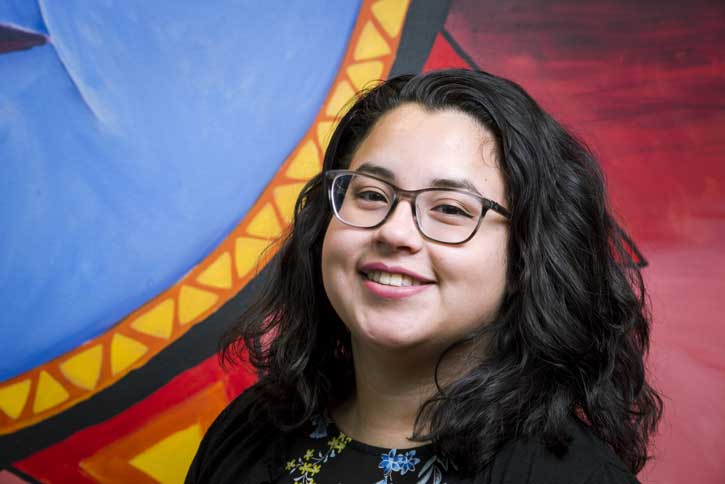
Genesis Lazo, a first-generation college student of parents from El Salvador, worked with Pamina Firchow to identify Everyday Peace Indicators for Mason students. Photo by Evan Cantwell.
Curious about what Mason students would name as “everyday peace indicators,” George Mason University professor Pamina Firchow and recent graduate Genesis Lazo assembled focus groups to provide the answer.
Lazo and Firchow, a professor in Mason’s School for Conflict and Resolution, recruited students and asked them in a series of panel workshops last fall. With Firchow moderating, the panelists were asked what brings them peace and what takes it away.
Everyday Peace Indicators, developed in 2012 by Firchow for use in post-conflict communities in Uganda, Zimbabwe, South Sudan and South Africa, among other places, are the environmental characteristics that create or remove a sensation of peace amid one’s surroundings. The project is “based on the premise that local communities are best placed to identify changes in their own circumstances, rather than relying on external ‘experts’ to identify indicators for them,” according to its website.
What they discovered was that Mason’s diverse student population is a strong key to individual and overall campus well-being.
“The conclusions could be helpful for decision-making on campus,” Firchow said.
Diversity was the top indicator selected by the panelists, Firchow said. Other indicators included campus security, campus space, faculty and staff support and “standing up to intolerance.”
Lazo suggested the findings could be applied in other settings, including other college campuses.
“Professor Firchow’s model was developed for small post-conflict communities in places like Zimbabwe and Colombia,” Lazo said. “A college campus’s conflicts aren’t large-scale like a war, but there are all sorts of different conflicts. In the end, it’s really the people who come up with their own indicators of peace.”
Examples of campus conflicts included the pastor who shouts insults and threats at students outside of the Johnson Center and the possibility of sexual assault. “Those two seem to be on students’ minds the most,” said Lazo, who graduated from Mason in 2016 with bachelor’s degrees in global affairs and conflict analysis and resolution.
Campus security, for example, was an indicator that both reassured peace and removed it, Lazo said.
“It’s different depending on who you are.”
But racial, political and cultural diversity was a peace indicator “across the board, in every group,” Lazo said. “There’s a comfort element at Mason: You can be your own person.”
Take that away, and everyday peace isn’t achieved.
Supported by a fellowship with the Shinnyo-en Foundation, Lazo is now writing the results of the research and disseminating it throughout the university.
Lazo’s parents are from El Salvador—her father is an immigrant and her mother is first-generation American—and during her four years at Mason the Woodbridge, Va., native became involved in Azucar, the Mason salsa dance club, and served as president of the school’s Model United Nations chapter, an opportunity she relished.
The yearlong Shinnyo-en post-graduate fellowship, which ends in June, gives her a chance to focus on service and engaging the community, which she did with the peace indicators study. Now she can work on her next project.
“I don’t know what to call it yet, but it will be a day of peace so that things that remove peace from students can be addressed, and the things that give more peace can be expanded on,” she said.
